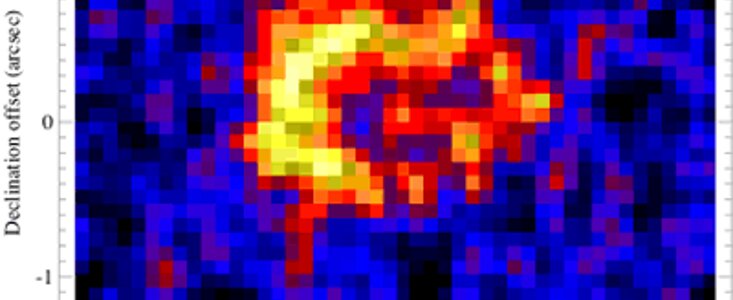Gemini South Obtains First High-Resolution Image of Dust Around Supernova 1987A
21 Julio 2004
Infrared observations of Supernova 1987A made in October 2003 as part of the “checkout” of the new Thermal-Region Camera Spectrograph (T-ReCS) instrument on Gemini South have revealed dust emissions at a wavelength of 10 microns, corresponding to a temperature of about 150 degrees Kelvin. They are coming from a cool dust ring that is surprisingly luminous. It co-exists with hot gas components left over from the relic equatorial ring so prominently featured in images and data from other observatories in wavelengths from X-ray to radio. This T-ReCS observation is the first detection of mid-infrared emission from the ejecta ring of SN1987A in five years.
The similarity of Gemini’s 10-micron image with those taken in X-ray images obtained by the Chandra Observatory, and at radio frequencies from the Australian National Telescope Facility, suggests that the thermal emission is due to the recent heating of pre-existing dust in the equatorial ring by the supernova blast wave. Several theoretical models predicted the presence of such dust in the circumstellar environment of SN1987A. It would have been expelled from the progenitor by a strong wind ejected during the last gasps of the dying star. The existence of the dust feature also indicates that the theoretical models were developed to explain the energy budget of SN1987A about 1,000 days after the outburst are not valid at this later stage–some 6,067 days post-outburst.
SN1987A is the closest known supernova to appear in the past 400 years and continues to provide astronomers with an incredibly detailed look at how a high-mass star evolves to its ultimate death. Fortunately, there is information available about the star that blew up, mainly through images and spectra taken before the January 1987 explosion. But the best window onto the state of the pre-outburst star comes from studying the gas shed during its rapid evolution just prior to the explosion. This material was lit up by the flash of the explosion, and now that the supernova has faded, astronomers can clearly see a complex structure around the explosion site, shaped by relic wind from the star.
The now well known "circumstellar envelope" surrounding the supernova consists of an inner, equatorial ring flanked by two outer rings. These rings form the “waist” and “caps” of an hourglass-shaped, bipolar nebula now about three light-years across. This feature is expanding at 10 kilometers per second at the equator and 25 kilometers per second at the poles, moving into a diffuse medium that has accumulated into a dense 13-light-year-wide shell.
In the next few years, radical changes will occur in the circumstellar environment as ejecta from the supernova itself (expanding at a substantial fraction of the velocity of light) rams into the nebula, giving birth to a formal supernova remnant. New hot spots will continue to appear as the whole equatorial ring lights up. Over the next several years it should brighten up a thousand-fold.
The October 2003 T-ReCS image also reveals a very faint source of emission at the position of the stellar explosion. By studying the evolution of the light of the explosion during the first three years after the outburst, astronomers Patrice Bouchet and Nicholas Suntzeff found that significant amounts of dust formed out of the metals synthesized in the explosion. Theoretical modeling of the evolution of this dust emission predicted that the light output from the explosion should have remained constant for many years. Instead the emission evidently has declined, a puzzling result given the theoretical expectations.
The T-ReCS data and images demonstrate the tremendous sensitivity of the instrument when combined with the infrared optimized Gemini South Telescope. The detection of the ejecta is among the faintest radiation ever detected from the ground at this wavelength regime. The detection was at a level of 0.32 (+/- 0.1) mJy.
For more details, see the paper "High Resolution Mid-Infrared Imaging of SN 1987A", by Patrice Bouchet, James de Buizer, Nicholas B. Suntzeff, I. John Danziger, Thomas L. Hayward, Charles M. Telesco and Christopher Packham, in The Astrophysical Journal, vol 611, pp. 394-398, 10 August 2004.
T-ReCS is a facility instrument at Gemini South and was built by the University of Florida.


